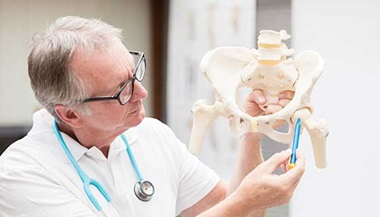Osteochondroma
What is osteochondroma?
Osteochondroma is an overgrowth of cartilage and bone that happens at the end of the bone near the growth plate. Most often, it affects the long bones in the leg, the pelvis, or the shoulder blade.
Osteochondroma is the most common noncancerous bone growth. It most often occurs between ages 10 and 30. It affects males and females equally.
What causes osteochondroma?
While the exact cause of osteochondroma is not known. There is one type that is inherited and one type that is not inherited.
What are the symptoms of osteochondroma?
These are the most common symptoms of osteochondroma:
- A hard, mass that is painless and does not move
- Lower-than-normal-height for age
- One leg or arm that is longer than the other
- Pressure or irritation with exercise
- Soreness of the nearby muscles
Often, people with osteochondroma will have no symptoms at all.
When they do happen, symptoms of osteochondroma may look like other medical problems. Always talk with your doctor for a diagnosis.
How is osteochondroma diagnosed?
Your healthcare provider will review your medical history and do a physical exam. Other tests include:
- X-ray. This test uses invisible electromagnetic energy beams to make images of tissues, bones, and organs.
- CT scan. This test uses X-rays and computer technology to make images (often called slices) of the body. A CT scan shows detailed images of any part of the body, including the bones, muscles, fat, and organs. CT scans are more detailed than general X-rays.
- MRI. This test uses large magnets, radiofrequencies, and a computer to make detailed images of organs and structures in the body.
How is osteochondroma treated?
Your healthcare provider will figure out the best treatment based on:
- How old you are
- Your overall health and medical history
- How sick you are
- How well you can handle specific medicines, procedures, or therapies
- How long the condition is expected to last
- Your opinion or preference
Treatment for osteochondromas varies depending on the size of the growth and your symptoms. Treatment may include:
- Surgery to remove the mass
- Medicines to control pain
If there is no sign of bone weakening or increased overgrowth, your healthcare provider may want to watch it over time. Careful follow-up with a healthcare provider to monitor bone growth may be advised.
Key points about osteochondroma
Osteochondroma is an overgrowth of cartilage and bone at the end of the bone near the growth plate. It affects males and females equally.
- Most often, it affects the long bones in the leg, pelvis, or shoulder blade.
- The exact cause of osteochondroma is not known.
- Symptoms may include:
- A hard mass that is painless and does not move
- Lower-than-normal-height for age
- Soreness of the nearby muscles
- One leg or arm that is longer than the other
- Pressure or irritation with exercise
- Treatment may include:
- Surgery to remove the mass
- Medicines to control pain
- Careful follow up with your healthcare provider may be advised to check bone growth.
Next steps
Tips to help you get the most from a visit to your healthcare provider:
- Know the reason for your visit and what you want to happen.
- Before your visit, write down questions you want answered.
- Bring someone with you to help you ask questions and remember what your healthcare provider tells you.
- At the visit, write down the name of a new diagnosis, and any new medicines, treatments, or tests. Also write down any new instructions your provider gives you.
- Know why a new medicine or treatment is prescribed, and how it will help you. Also know what the side effects are.
- Ask if your condition can be treated in other ways.
- Know why a test or procedure is recommended and what the results could mean.
- Know what to expect if you do not take the medicine or have the test or procedure.
- If you have a follow-up appointment, write down the date, time, and purpose for that visit.
- Know how you can contact your healthcare provider if you have questions.





